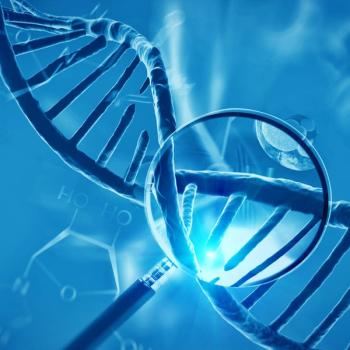
- December 2024
- Volume 18
- Issue 5
How ctDNA Testing Is Being Used To Diagnose And Monitor Cancer
The role of circulating tumor DNA is growing: From detecting early disease to guiding treatment plans, clinicians are finding ctDNA testing increasingly important.
Ashly Grafton, RN, MS-CRM, a clinical research nurse at City of Hope Orange County Lennar Foundation Cancer Center in Irvine, California, has seen firsthand how circulating tumor DNA (ctDNA) testing has become an emerging tool in oncology care.
“ctDNA testing looks for small pieces of DNA found in a patient’s blood that comes from cancer cells and tumors,” Grafton explains. “Screening for ctDNA can be used to detect cancer early, before symptoms occur, and also to monitor tumor growth in cases where cancer has already been detected.”
Grafton’s experiences with ctDNA testing stem from being both an oncology nurse and a former patient with cancer, as she was diagnosed with stage II triple-negative breast cancer at the age of 32.
“Now that I’m 5 years out and tumor-free, just knowing that my ctDNA is being tested annually and compared to my original baseline gives me peace of mind.” -Ashly Grafton, RN, MS-CRM
“When I was first diagnosed with cancer, ctDNA testing wasn’t a regular testing procedure,” she says. “Now that I’m 5 years out and tumor-free, just knowing that my ctDNA is being tested annually and compared to my original baseline gives me peace of mind. I know any discrepancies in my testing will be caught at the earliest possible juncture.”
What Is ctDNA Testing?
ctDNA testing—which is commonly referred to as a liquid biopsy—analyzes a patient’s blood to detect DNA fragments from cancer cells. If the patient had already undergone cancer treatment, these fragments are known as minimal residual disease (MRD). The technique offers a more comprehensive picture of a patient’s cancer burden than a traditional tissue biopsy by showing residual cancer cells that may be present following surgery.
The test has been shown to be a promising way to detect early-stage cancer and identify patients who are at a high risk of recurrence and may need further treatment. Results from the observational BESPOKE CRC study (NCT04264702), presented at the 2024 American Society of Clinical Oncology Gastrointestinal Cancers Symposium, found patients with stage II/III colorectal cancer who were found to be MRD positive per ctDNA testing tended to live longer after receiving adjuvant chemotherapy compared with those who didn’t receive chemotherapy.1
Deborah Mrema, NP, RN, an advanced practice nurse in surgical oncology at The University of Texas MD Anderson Cancer Center, in Houston, Texas, sees ctDNA testing as an additional diagnostic tool that can help guide cancer treatment decisions. In her practice, she cares for patients with colon and rectal tumors that have spread to the liver, as well as those with primary liver cell carcinoma.
“Rather than being a stand-alone test, ctDNA testing serves as a supplement to the National Comprehensive Cancer Network [NCCN] guidelines,” she says. “As an example, NCCN recommends patients with colorectal liver metastasis should be monitored with a carcinoembryonic antigen test and [CT] imaging.”
At MD Anderson, ctDNA testing is being utilized both for new oncology cases and to monitor how current patients are responding to ongoing treatment.
“For new patients, we use ctDNA testing to look for mutations, such as KRAS G12C, that might be involved with their tumor,” she says. “If a patient has KRAS mutation or a RAF mutation, that’s going to signify that we should add a specific targeted therapy in addition to chemotherapy.”
In some cases, ctDNA testing can also show that chemotherapy after surgery might not be needed. One study found ctDNA status following colorectal surgery can be used to avoid adjuvant chemotherapy while maintaining recurrence-free survival rates for some patients with stage II colon cancer.2
ctDNA HELPS GUIDE TREATMENTS
Mrema acknowledges that while ctDNA testing offers many benefits, it can increase anxiety for some patients, especially when their ctDNA test result comes back positive. Mrema notes that a positive result indicates a more than 90% chance the patient’s cancer will recur at some point.
“It can be hard for patients to learn their ctDNA test came back positive despite [having] no evidence of the disease found through CT imaging,” she says. “We explain to patients how ctDNA tests detect [MRD] that may still be present in their bloodstream yet is too small to be picked up by CT imaging.”
Even when a ctDNA test comes back positive, Mrema says it doesn’t necessarily indicate a patient needs to restart treatment.
“We know there’s a potential for the cancer to return, but we may decide a patient with a positive ctDNA test should first repeat a CT or PET scan,” she says. “Through early detection and regular monitoring, we can detect and treat any relapse of their cancer early.”
Another option, according to Mrema, is to refer patients with a positive ctDNA test to one of the MRD-focused clinical trials currently taking place at cancer treatment centers in the United States. While some patients may receive targeted therapy as part of the clinical trial, others might be recommended lifestyle changes such as daily walking and taking vitamin D and aspirin.
Mrema says that through an ongoing clinical trial MD Anderson researchers have learned that patients with low-risk stage II colon cancer did not tend to have improved ctDNA clearance with 6 months of adjuvant chemotherapy.1
“Measuring ctDNA appears to be one of the tools that can [help] us differentiate between high-risk and low-risk patients.” -Deborah Mrema, NP, RN
“Our clinical trial has shown some patients who are at a low risk of [progressing to] stage IV cancer didn’t need chemotherapy post-surgery,” she says. “Measuring ctDNA appears to be one of the tools that can [help] us differentiate between high-risk and low-risk patients.”
HOW ctDNA TESTING COMPARES WITH OTHER TESTING
Since ctDNA testing looks for small pieces of DNA in the blood that come from cancer cells and tumors, Grafton says the testing can be used as a supplemental method of assessing a tumor’s size and rate of progression.
“The ctDNA test offers a noninvasive, sensitive, and specific option that provides more information than a traditional tissue biopsy that doesn’t always detect cancer in its earliest stages,” Grafton says. “Other techniques, including examination of tumor-relevant protein molecules, microRNAs, and circulating tumor cells, are often less specific in their results than ctDNA.”
Despite the many advantages of ctDNA testing, there are some limitations. According to Grafton, ctDNA testing may not be able to detect early-stage tumors that are less than 1 cm in diameter. One recent study found that in cases of lung cancer, low-volume disease couldn’t be reliably detected using mutation profiles in ctDNA. In addition, the study found some specific types of lung adenocarcinoma don’t shed detectable ctDNA into the peripheral blood.2
Mrema says ctDNA testing can also prove inaccurate in cases where the patient doesn’t have a high tumor burden.
“If we see a patient who has 1 solitary spot in their liver vs somebody who has 10 or 15 spots, the tumor burden is going to be different,” she says. “For the patient with a solitary liver metastasis, their ctDNA test can come back negative just because there won’t be a lot of DNA in the bloodstream. In those cases, we need to wait for the comprehensive mutation analysis from the tissue.”
DISCUSSING ctDNA RESULTS WITH PATIENTS
Talking to patients about ctDNA testing and how to interpret the results is an important part of the treatment process, says Mrema.
“When we see a patient for the first time, the doctor and I will talk to the patient about how we’re going to incorporate ctDNA monitoring into their care plan,” she says. “It’s important to prepare patients and to educate them on the purpose of the test, what it involves, and what the results indicate.”
Grafton notes that ctDNA monitoring can affect overall cancer experience too. Since imaging can be costly and it takes time for the results of a scan to come back, it can cause stress and anxiety for many patients.
“The process of waiting for imaging tests, including the time involved in determining [whether] a treatment is working or not, can cultivate stress and even delay continuing treatment,” she says. “Monitoring with a simple blood test, checking for ctDNA from a draw, and getting results the same day can greatly streamline decision-making for the patient in terms of treatment.”
When discussing ctDNA results with patients, the key is transparency, Mrema says. As an example, she cites a recent patient who had a ctDNA test that came back positive, yet there were no signs of the disease on imaging tests.
“Because of the trust we had established with the patient, he continued to return to MD Anderson for scans every 3 months as recommended by the NCCN guidelines,” Mrema says. “A year later, when the disease was apparent on his CT scan, we took him back to surgery and removed the cancer. Today, he’s doing great.”
TESTING MIGHT NOT BENEFIT EVERY PATIENT
Although ctDNA testing can be an important tool in cancer detection, prognosis, and disease progression, it does come with some limitations. According to Grafton, screening for ctDNA can be helpful in diagnosing patients with advanced cancers of the ovary, pancreas, liver, lung, bladder, colon, stomach, breast, esophagus, or head and neck.
Researchers are still working to determine whether ctDNA testing can be an effective tool in monitoring other forms of cancer.
“Detecting ctDNA in patients who have kidney, prostate, and thyroid cancers can be more challenging,” she says.
As an example, Mrema learned how ctDNA testing can indicate a negative result despite presence of metastatic disease in a patient’s lungs.
“We use ctDNA testing about a month after completion of all treatments to check for MRD,” she says. “We’ve found the test isn’t as sensitive for metastasis in the lungs.”
Researchers are currently investigating how ctDNA testing may benefit detection of additional types of cancer. One study found the ctDNA detection rate for prostate cancer is over 77%, while ctDNA detection rates in other types of cancer can be over 90%.4
While Grafton says there are data suggesting the sensitivity of ctDNA has been overestimated for screening purposes, she notes that researchers and clinicians generally agree that ctDNA screening has value if it’s done in conjunction with other detection methods.
“Doing ctDNA testing offers an additional layer of detection, looking for early indicators in patients who might be at high risk of recurrence,” Mrema says.
The testing also shows promise in detecting cancer earlier, before symptoms appear. Since colon cancer is often diagnosed in advanced stages, one study found detection of ctDNA markers was possible up to 2 years prior to a clinical diagnosis of colorectal cancer. Research suggests some cases of colorectal cancer might be diagnosed earlier if ctDNA tests were made a part of colon cancer screening guidelines.3
REFERENCES
- Morris VK, Yothers G, Kopetz S, et al. Phase II results of circulating tumor DNA as a predictive biomarker in adjuvant chemotherapy in patients with stage II colon cancer: NRG-GI005 (COBRA) phase II/III study. J Clin Oncol. 2024;42(suppl 3):5. doi:10.1200/JCO.2024.42.3_suppl.5
- Chakrabarti S, Kasi AK, Parikh AR, Mahipal A. Finding Waldo: the evolving paradigm of circulating tumor DNA (ctDNA)—guided minimal residual disease (MRD) assessment in colorectal cancer (CRC). Cancers (Basel). 2022;14(13):3078. doi:10.3390/cancers14133078
- Brenne SS, Madsen PH, Pedersen IS, et al. Colorectal cancer detected by liquid biopsy 2 years prior to clinical diagnosis in the HUNT study. Br J Cancer. 2023;129(5):861-868. doi:10.1038/s41416-023-02337-4
- Domrazek K, Pawłowski K, Jurka P. Usefulness of BRCA and ctDNA as prostate cancer biomarkers: a meta-analysis. Cancers (Basel). 2023;15(13):3452. doi:10.3390/cancers15133452.

















































































